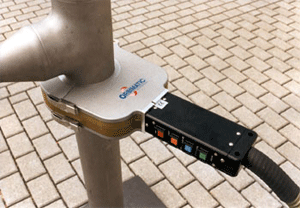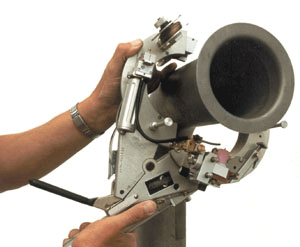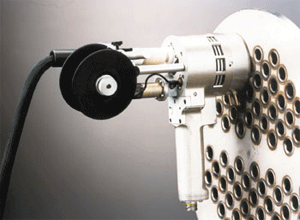Sales Manager
- FMA
- The Fabricator
- FABTECH
- Canadian Metalworking
Categories
- Additive Manufacturing
- Aluminum Welding
- Arc Welding
- Assembly and Joining
- Automation and Robotics
- Bending and Forming
- Consumables
- Cutting and Weld Prep
- Electric Vehicles
- En Español
- Finishing
- Hydroforming
- Laser Cutting
- Laser Welding
- Machining
- Manufacturing Software
- Materials Handling
- Metals/Materials
- Oxyfuel Cutting
- Plasma Cutting
- Power Tools
- Punching and Other Holemaking
- Roll Forming
- Safety
- Sawing
- Shearing
- Shop Management
- Testing and Measuring
- Tube and Pipe Fabrication
- Tube and Pipe Production
- Waterjet Cutting
Industry Directory
Webcasts
Podcasts
FAB 40
Advertise
Subscribe
Account Login
Search
Assessing developments in orbital welding—Part 1
Taking the monotony out of tube welding
- By Steve Purnell
- September 12, 2002
- Article
- Tube and Pipe Fabrication

Figure 1 Enclosed-arc weld heads do not allow oxygen to enter the tube. When an internal gas purge is used, gaps in the weld joint do not degrade the quality of the internal weld.
The GTAW Process
Editor's Note: This article is the first part of a two-part series about developments in orbital welding. Part I discusses power supplies, weld heads, and electrodes. Part II, which will appear in the October/November issue, will focus on hardware and accessories that improve weld quality and software that documents each weld.
Orbital welding, which the aircraft industry pioneered in the 1960s, is an automated welding process in which a tungsten electrode rotates, or orbits, around a tube. This automated process was developed to provide more consistent results than manual welding methods. By the 1980s manufacturers had developed this idea more thoroughly and had begun to produce dedicated welding systems. However, the controls and software were not user-friendly by today's standards. Early systems had analog controls, and programs had to be recorded and an entire program re-entered each time a specific task was performed.
Despite the lack of sophisticated controls, the equipment achieved excellent repeatability in production and tight-specification applications.
Today's orbital welding equipment is outfitted with more advanced technology. It is easier to use and provides even better results than the equipment that was produced two decades ago.
Orbital welding uses the gas tungsten arc welding (GTAW) process with direct current, electrode negative (DCEN) or alternating current (AC).
DCEN distributes heat constantly with two-thirds of the weld heat in the workpiece and the other third in the electrode. AC provides balanced heat because it switches polarity, which can be set to a rate between 50 and 200 hertz (Hz). The AC balance can be adjusted to control the arc contour and, in turn, the weld profile.
The weld is surrounded by an inert gas, commonly argon. Some gas mixtures allow faster welding speeds, increase penetration, and produce a cleaner weld bead. Most common gas mixtures are combinations of argon and hydrogen and argon and helium. The gas type selected depends on the material, application, and economic factors.
The most commonly used tungsten electrodes for DCEN welding are thoriated. Other types of electrodes can be used, but it is generally considered that thoriated tungsten electrodes perform the best in the widest range of applications.
For AC applications, the use of zirconiated tungsten electrodes is most common. It is important to select an electrode type that provides a stable, balled end when welding. The characteristics of AC prevent the electrode from sustaining a pointed profile.
Orbital Welding Equipment
An orbital welding system comprises two main components: an orbital welding head and a power supply. The weld head rotates the torch or electrode and performs the weld cycle. The power supply provides power and controls the system.
Power Supply. Modern orbital welding power supplies control welding current, rotation control, wire feed, and gas flow. Feedback from the weld head helps to maintain a consistent weld profile. These power supplies are equipped with a built-in cooling unit that circulates a liquid coolant to the sensitive parts of the weld head.
Additionally, these units can store hundreds of weld procedures that include details about the tungsten electrode, gas type and flow, joint preparation, parent material, and filler materials used. They have extensive integral data acquisition capabilities that allow weld data logs to be loaded to a PC card and transferred directly to a PC for storage.
Modern power supplies also include an autoprogram capability that reduces the amount of time needed to develop a suitable weld procedure for an application. These systems take into account tube size, material, and shielding gas to determine the appropriate welding parameters. Other standard features are printers, fault sensors, key switch, and weld head recognition.
AC applications use an AC/DC power supply that offers all the standard functions of a DC machine. In addition, AC/DC power supplies contain an AC generation module that allows operators to control the AC frequency and balance in addition to the standard parameters.Weld Head. Three common types of weld head are fully enclosed fusion weld head, open-arc wire feed weld head, and tube-to-tube-sheet weld head.
- Fully enclosed weld heads weld in a localized chamber formed by the clamping system around the tube (see Figure 1) . This chamber is filled with inert gas before welding, which fully protects the outer surface of the tube and the tungsten electrode. This weld head style is available for tubes with ODs ranging from 2 to 170 millimeters.
- Open-arc weld heads (see Figure 2) are used for thick-wall applications or those in which wall thickness exceeds 3.5 mm. In addition, they allow the use of a filler material and multiple-pass weld sequences. The weld torch block can tilt up to 45 degrees for fillet welding and joining short leg fittings. An arc length controller regulates the tungsten gap, which ensures a consistent profile, even on oval pipes.
- Tube-to-tube-sheet weld heads are used in the manufacture and repair of heat exchangers (see Figure 3) . A heat exchanger usually has a tube sheet and several hundred tubes that must be welded to it. This application is mundane and repetitive, so eliminating operator fatigue is a benefit of this type of weld head. The welder's only duties are to ensure the tubes are fitted correctly and to operate the machine.
About the Author
Steve Purnell
P.O. Box 416 Welbeck Way
Peterborough, PE7 3FT
49-6408-90260
About the Publication
Related Companies
subscribe now

The Tube and Pipe Journal became the first magazine dedicated to serving the metal tube and pipe industry in 1990. Today, it remains the only North American publication devoted to this industry, and it has become the most trusted source of information for tube and pipe professionals.
start your free subscription- Stay connected from anywhere

Easily access valuable industry resources now with full access to the digital edition of The Fabricator.

Easily access valuable industry resources now with full access to the digital edition of The Welder.

Easily access valuable industry resources now with full access to the digital edition of The Tube and Pipe Journal.
- Podcasting
- Podcast:
- The Fabricator Podcast
- Published:
- 04/16/2024
- Running Time:
- 63:29
In this episode of The Fabricator Podcast, Caleb Chamberlain, co-founder and CEO of OSH Cut, discusses his company’s...
- Trending Articles
Team Industries names director of advanced technology and manufacturing

Orbital tube welding webinar to be held April 23

Chain hoist offers 60-ft. remote control range

Push-feeding saw station cuts nonferrous metals

Corrosion-inhibiting coating can be peeled off after use

- Industry Events
16th Annual Safety Conference
- April 30 - May 1, 2024
- Elgin,
Pipe and Tube Conference
- May 21 - 22, 2024
- Omaha, NE
World-Class Roll Forming Workshop
- June 5 - 6, 2024
- Louisville, KY
Advanced Laser Application Workshop
- June 25 - 27, 2024
- Novi, MI




























